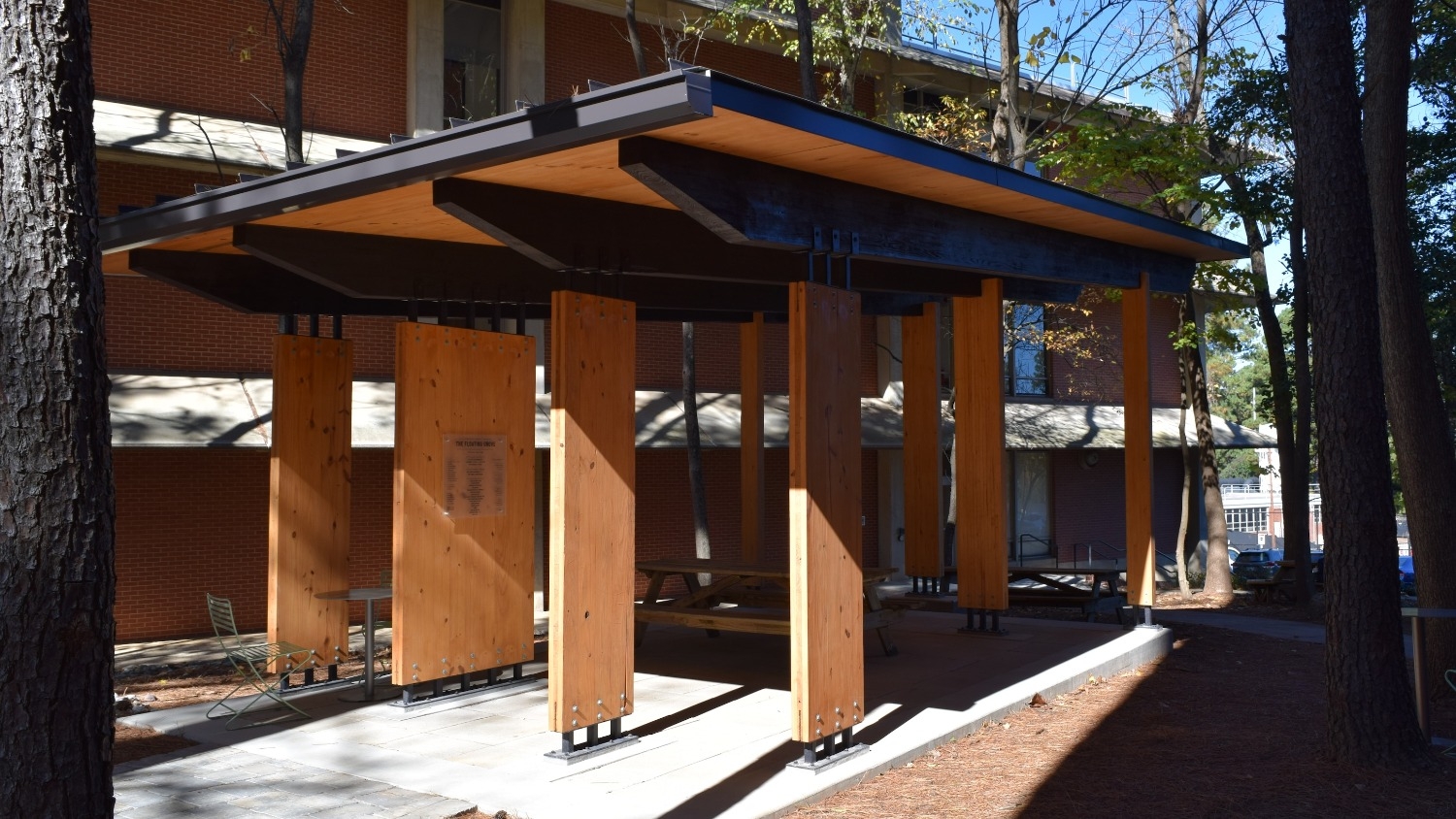The Importance of Design

She’s from Wisconsin and enjoys cheese and writing (not necessarily in that order), plays the piano, and believes that all design disciplines are connected and that communication is fundamental to developing solutions. With nearly 10 years of professional experience from creating identity systems, exhibition design, and user-centered research, Allison McCulloh Karas understands how to approach a design problem. It is her passion and one of the reasons she is currently pursing her master’s in graphic design at the College of Design.
Karas is a 2008 graduate of Iowa State University with a B.F.A. in graphic design. She worked as a designer at Skidmore Owings & Merrill LLP (SOM) in Chicago, IL. While at SOM, she collaborated with multiple disciplines including architects, interior designers, engineers, and landscape architects on a variety of projects. She strategized print and digital visual communications for urban design, architecture, high performance design, interior design, and business development. “As a designer, you need to clearly and effectively present visual solutions – in simple terms, clean graphics – to communicate the message. At SOM, I helped tell their story with books, presentations, and exhibitions. I realized I wanted more,” Karas said. “When I looked around, people were teaching, working in agriculture and so many other big things. I decided to find a way to make graphic design bigger.”
This passion and need to utilize graphic design to make a difference led her to the College of Design. Karas was inspired by the design process used by architects and how they look at things on such a large system and scale. Working with projects focusing on urban planning, she was exposed to the benefit of multiple disciplines coming together to solve problems. “In this environment (urban planning), you are working on such large problems and the need to solve major things. NC State stood out because of all the disciplines and the importance they placed on working together. I also loved the opportunity of the large university setting which allowed me to take additional courses such as anthropology.”
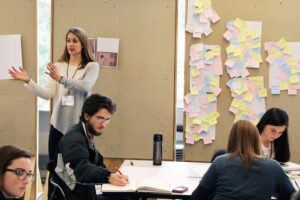 Karas is currently a teaching assistant for undergraduate typography and graphic design theory at the College of Design. She also taught a course during Design Camp last summer and has developed and presented a hands-on interdisciplinary curriculum workshop for the Design Lab for K-12 Education. Her most recent courses were targeted toward high school students and focused on graphic design and branding. At the core of both of these lessons is that different ideas, objects, spaces, and memories combine to form a design system and emphasis that design is involved at every point of the process.
Karas is currently a teaching assistant for undergraduate typography and graphic design theory at the College of Design. She also taught a course during Design Camp last summer and has developed and presented a hands-on interdisciplinary curriculum workshop for the Design Lab for K-12 Education. Her most recent courses were targeted toward high school students and focused on graphic design and branding. At the core of both of these lessons is that different ideas, objects, spaces, and memories combine to form a design system and emphasis that design is involved at every point of the process.
During last summer’s Design Camp, Karas taught a design foundations course which encouraged students to explore design thinking. The theme of the camp was Food and Sustainability. Individual lessons were intended to bring a different disciplinary approach to design and to reinforce that all design problems are connected no matter what discipline you practice. Using the theme, Karas developed a creative exploration of a cafeteria setting. The premise was to have students think broadly in their interpretation of a cafeteria and all the approaches of design that can influence and change a cafeteria, including the food packaging, the serving line, the physical space, the tables, walls, and chairs.
 Karas had students model the cafeteria space in 3D using recycled food containers such as egg cartons and cereal boxes. Her hope was that through this process, the students would understand and appreciate the many approaches that could be configured to create the space in addition to working collaboratively to make decisions. Building upon this lesson, she moved to a 2D mapping project where students were encouraged to identify touch points of where there could possibly be breakdowns or issues in the experience within the cafeteria. In other words—where design could improve the experience. Objects considered were chairs or furniture that could be better positioned or designed, improved signage, and the incorporation of a robotic machine that delivered or dispensed your meal.
Karas had students model the cafeteria space in 3D using recycled food containers such as egg cartons and cereal boxes. Her hope was that through this process, the students would understand and appreciate the many approaches that could be configured to create the space in addition to working collaboratively to make decisions. Building upon this lesson, she moved to a 2D mapping project where students were encouraged to identify touch points of where there could possibly be breakdowns or issues in the experience within the cafeteria. In other words—where design could improve the experience. Objects considered were chairs or furniture that could be better positioned or designed, improved signage, and the incorporation of a robotic machine that delivered or dispensed your meal.
“I’ve learned that not every student or person interprets your design problem the same. Everyone has a different or unique understanding. I learned this through teaching. It was interesting and unexpected to see some of the students’ interpretations,” she said. And it’s the interpretation of a problem or solution that provides better problem solving when the collaborative process is incorporated. Each person can bring a unique perspective or interpretation to the project that allows for a wider reach of ideas, which leads to conversation and the generation of even more ideas.
 For the workshop, Karas’ intent was to use the influence of graphic design and the concept of branding to inspire students to think differently using design thinking. The course title was Breaking and Building a Brand and provided the opportunity to view design and brand through a new lens. “Brand is not just a logo, it’s so much more. I wanted a way to push this idea and teach them a take-away method,” Karas said.
For the workshop, Karas’ intent was to use the influence of graphic design and the concept of branding to inspire students to think differently using design thinking. The course title was Breaking and Building a Brand and provided the opportunity to view design and brand through a new lens. “Brand is not just a logo, it’s so much more. I wanted a way to push this idea and teach them a take-away method,” Karas said.
Because the workshop is a six-hour class, Karas realized that using software was not an option. However, the workshop still had to be hands-on. Her goals were to provide individual and group setting interaction, teach students something that they could utilize again, and incorporate sketching, writing, and ideation. Students had the opportunity to use the design process and core visual design principles to break down what makes up a brand, and then use this learned knowledge and understanding to create (or recreate) an identity of their own.
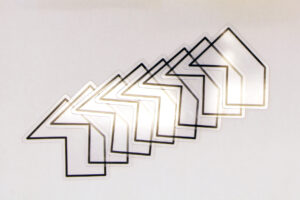
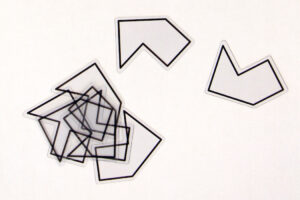 Karas divided the workshop into different lessons. Each lesson would lend itself to the next so that students could further explore design thinking. She introduced game cards from “On the Line,” a product that Assistant Professor of Graphic Design Dr. Derek Ham helped design during his PhD at M IT. She modified the intent of the original game in order to guide students through the process of communicating a word or message with the use of pattern or image. “How do you convey active, cool, fast, or different words that they thought should be strong in the identity of the brand they were creating?” Kar
Karas divided the workshop into different lessons. Each lesson would lend itself to the next so that students could further explore design thinking. She introduced game cards from “On the Line,” a product that Assistant Professor of Graphic Design Dr. Derek Ham helped design during his PhD at M IT. She modified the intent of the original game in order to guide students through the process of communicating a word or message with the use of pattern or image. “How do you convey active, cool, fast, or different words that they thought should be strong in the identity of the brand they were creating?” Kar as said. The process of using these cards and organizing them in a way that the final image was reflective of a specific word or emotion was just another way Karas inspired these students to think about design and how to convey a message.
as said. The process of using these cards and organizing them in a way that the final image was reflective of a specific word or emotion was just another way Karas inspired these students to think about design and how to convey a message.
Karas introduced logos that were both easily and not easily identifiable with the intention of providing an opportunity to move past any bias. From the visuals of the logos, students were asked to brainstorm words that were reflective of the brand and then think of the opposite and how they would visually present it. “When you think of Target, we immediately visualize the red target,” Karas emphasized. “I showed them other marketing visuals from Target such as ads and flyers which showed them that there are different ways to present the brand and the idea.” Karas had students explore the many different ways a brand is being represented including radio ads, the physical space, and other recognizable forms.
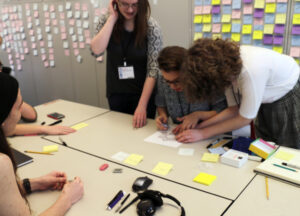 “The whole workshop was on branding and how it can be seen as something that is expensive or limiting. As graphic designers we are building brands and visual identities; however, the application of these brand elements such as the website, the physical space, and the logo are part of our everyday lives. The interactions—these all together form a system. The system approach and the user experience is so important,” she said.
“The whole workshop was on branding and how it can be seen as something that is expensive or limiting. As graphic designers we are building brands and visual identities; however, the application of these brand elements such as the website, the physical space, and the logo are part of our everyday lives. The interactions—these all together form a system. The system approach and the user experience is so important,” she said.
Making graphic design bigger is important to Karas but she also wants to influence the students she taught. “As designers, our future problems are too complex to solve and we need to engage other people in this process, not just designers. We need to be comfortable approaching others in a more collaborative way. It’s important that if you are interested in design, you need to find ways to build upon this. It’s the process that builds up to collaboration, not just the programs – you need to think bigger.”

